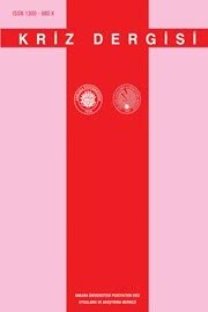Krize müdahale triyaj değerlendirme sistemi Triage Assessment System Crisis Intervention
Krize müdahale, kriz değerlendirmesi, triyaj değerlendirme, bilişsel, duygusal, davranışsal
Triage Assessment System Crısıs Interventıon
Crisis intervention, triage, cognitive, affective, behavioral,
___
- Aguilera DC (1998) Crisis intervention: Theory and methodology (8th Ed.). St. Louis, MO: Mosby.
- Beck AT ,Weissman A, Lester D ve ark. (1974) The measurement of pessimism: the hopelessness scale. Psychol, 42(6): 861-865. J Consult Clin
- Belkin NJ (1984) Cognitive models and information transfer. Information Studies, 4(2): 111-129. Social Science
- Bengelsdorf H, Levy LE, Emerson RL ve ark.(1984) A crisis triage rating scale brief dispositional assessment of patients at risk for hospitalization. J Nerv Ment Dis , 172(7): 424- 430.
- Blancett J (2008) A reliability and validity study of the Triage Assessment System for Individual in Learning Environments. University of Memphis, Memphis, TN.
- Brownfield JN (2012) The reliability and validity of the Triage Assessment Scale for Students in Learning Environments: Middle schools (Doctoral Thesis). Available from Proquest Digital Theses database (Record no: 3502768).
- Butcher JN, Koss MP (1978) Research on brief and crisis-oriented psychotherapies.In S. L. Garfield and A. E. Bergin (Eds.), Handbook of Psychotherapy and Behavior Change. New York: John Wiley.
- Collins BC, Collins TM (2004) Crisis and Trauma: Developmental-ecological intervention. Boston, MA.: Lahaska Press.
- Conte C (2005) Examination of the reliability and validity of the Triage Assessment Survey: Organizations. Duquesne University, Pittsburgh, PA.
- Dass-Brailsford PA (2007) A practical approach to trauma: Empowering interventions. Publications.
- Hendricks JE, McKean J, Hendricks CG (2003) Crisis intervention, (3rded). Springfield, Illinois: Thomas Publishers, Ltd.
- Hillman JL (2002) Crisis intervention and trauma: New approaches to evidence-based practice. New York: Springer.
- Hoff M, Hoff LA (2012) Crisis education and service program designs: A guide for administrators, educators, and clinical trainers. Rev. Ed. New York & London: Routledge.
- James RK, Gilliland BE (2013) Crisis intervention strategies, (7th ed.).Pacific Grove, CA: Brooks/Cole.
- Jobes DA, Eyman JR, Yufit RI (1995) How clinicians assess suicide risk in adolescents and adults. Crisis Intervention & Time-Limited Treatment, 2 (1): 1-12.
- Kanel K (2014) A guide to crisis intervention. Belmont, CA: Brooks/Cole.
- Kliman A (1978) Crisis: Psychological first aid for recovery and growth. New York: Holt Rinehart & Winston.
- Lewis S, Roberts AR (2001) Crisis assessment tools: The good, the bad and the available. Brief Treatment and Crisis Intervention, 1(1): 17-28.
- Linehan MM, Goodstein JL, Nielsen SL ve ark. (1983) Reasons for staying alive when you are thinking of killing yourself: the reasons for living inventory. J Consult Clin Psychol, 51(2): 276.
- Myer R (2001) Assessment for crisis intervention: A triage assessment model. Brooks/Cole Thomson Learning.
- Myer RA., Conte C (2006) Assessment for crisis intervention. J Clin Psychol, 62(8): 959- 970.
- Myer RA, Lewis S, James RK (2013) Introduction to the task Model for crisis intervention. Journal of Mental Health Counseling, 35: 95-107.
- Myer RA, Hanna FJ (1996) Assessment and crisis management in the emergency room.in A. R. Roberts (Ed.), Crisis intervention and time-limited treatment (pp. 37-59). Pacific Grove, CA: Brooks/Cole.
- Myer RA, James RK (2005) CD-Rom and Workbook for Crisis Intervention. Belmont, CA: Brooks-Cole/Thompson.
- Myer RA, Ottens AJ (1994) Assessment for crisis intervention on college campuses.Crisis Intervention, 1: 31-46.
- Myer RA, Peterson SE, Willow RA (2002) Assessment of Children and Adolescents in Crisis. Trauma and Loss: Research and Interventions, 2 (1): 2-12.
- Myer RA, Williams RC, Ottens AJ ve ark. (1992) Crisis assessment: A three dimensional model for triage. Journal of Mental Health Counseling, 14: 137-148.
- Myer RA, Patrice M, Cogdal P ve ark. (2007) Triage assessment system training manual higher education, instructor’s manual, CIP-Solutions, Inc.
- Nuirus PS, Hudson WW (1993) Human services practice, evaluation, and computers: A practical guide for today and beyond. Pacific Grove, CA: Brooks/Cole.
- Overall JE, Gorham DR (1962) The brief psychiatric rating scale. Psychol Rep, 10(3): 799-812.
- Pazar JP (2005) A reliability study of the Triage Assessment Scale. Dissertation Abstracts International-B, 66/12.
- Pollin I (1995) Medical crisis counseling: Short-term therapy for long- term illness. New York: Norton.
- Pumariega AJ, Rogers K, Rothe E (2005) Culturally competent systems of care for children’s mental health: Advances and challenges. Community Ment Health J, 41(5), 539-555.
- Roberts AR (1991) Contemporary perspectives on crisis intervention and prevention, 3-17. Englewood Cliffs, NJ: Prentice Hall.
- Roberts AR (1996) The epidemiology and definitions of acute crisis in American society. treatment: Theory, technique and applications, 16-33, Chicago: Nelson Hall.
- Roberts AR (2000) Crisis intervention handbook: Assessment, treatment, and research. New York: Oxford university press.
- Rogers JR, Lewis MM, Subich LM (2002) Validity of the Suicide Assessment Checklist in an emergency crisis center. Counseling and Development, 80(4): 493-502. Journal of
- Rosenbaum R, Hoyt MF, Talmon M (1990) The challenge of single-session therapies: Creating pivotal moments. In R. A. Wells & V. J. Giannetti (Eds.), Handbook of the brief psychotherapies (pp. 165–189). New York: Plenum Press.
- Slagel L (2009) Examination of the reliability and validity of the Triage Assessment Survey: Families. Duquesne University, Pittsburgh, PA.
- Watters DS (1997) A study of the reliability of the Triage Severity Scale.Dissertation Abstracts International, 58- 08A, 3028.
- Wiger DE, Harowski KJ (2003) Essentials of crisis counseling and intervention. Hoboken, N.J.: John Wiley & Sons.
- ISSN: 1300-980X
- Başlangıç: 1992
- Yayıncı: Ankara Üniversitesi
Travma kavramının psikiyatri tarihindeki seyri
Ahmet KOKURCAN, Hamdi ÖZSAN HÜSEYİN
Krize müdahale triyaj değerlendirme sistemi Triage Assessment System Crisis Intervention
Gelişimsel travmanın uzun dönem etkileri ve bunlara aracılık eden nörobiyolojik mekanizmalar
